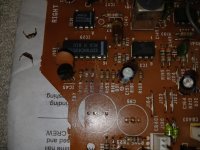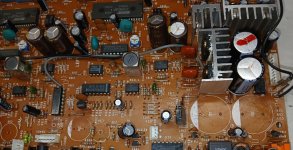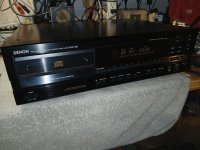One thing is, this is built very nice and to be serviced. Board came out very easy, will have the caps removed and see what's under them in a few hrs.
It's some type of hot melt. I suspect the color purple was to match the color some waht of the filter caps. It only comes off with heat and scraping. Messing up the silk screen some. Cap test like new they are going back in, show no sing of leakage (my tester cant test the large 2200uf 50v). Changing out the two resistors only because they are too hard to clean a d I have some, specs are right on.
Attachments
May have been epoxy or silicone, applied by a previous owner?
But purple?
Smell will tell you what it was, be careful, do it in a ventilated area.
Just heat the scrapings with a gas or electric heater, a cigarette lighter of the flameless kind, heat gun, soldering iron...you get the idea.
But purple?
Smell will tell you what it was, be careful, do it in a ventilated area.
Just heat the scrapings with a gas or electric heater, a cigarette lighter of the flameless kind, heat gun, soldering iron...you get the idea.
Thats a idea. It seems every so slightly soft, though looks like it leached into the pcb a bit in spots. Overall, very thin of what is left. Purple seems odd, but the caps are a sorta purple. I see no discoloration from the caps, so its not from there. I purchased this myself in the late 80s or early 90s when it just came out. It retailed 750, I took a hosing being I purchased this when it came out new. Maybe 700 with tax, had to pay top dollar. It's never been worked on and always worked except the cd changer tray would stick all the time.
We used to see wax on the small gang tuners, and IFTs on radios, sometimes red colored.
It was a mark that the alignment had been done, and tested OK.
So this purple stuff may be an internal QC or process mark during testing.
If it has not done any damage, I would check for corrosion, and leave it alone.
It was a mark that the alignment had been done, and tested OK.
So this purple stuff may be an internal QC or process mark during testing.
If it has not done any damage, I would check for corrosion, and leave it alone.
Nope.
I can tell you with certainty that Denon used thread lock (like everyone else) on screws, and they did use adhesive with large components on PCBs (like everyone else). Anything Denon used was susceptible to lacquer thinner.
The wax NareshBrd is referring to use used in RF circuits. It has a very low melting point and was more to damp vibration and keep slugs from moving in tuning cores for RF transformers and inductors. Easily removed with a screwdriver, blade or stiff cardboard / plastic. We would use candle wax to reapply it after alignment.
I can tell you with certainty that Denon used thread lock (like everyone else) on screws, and they did use adhesive with large components on PCBs (like everyone else). Anything Denon used was susceptible to lacquer thinner.
The wax NareshBrd is referring to use used in RF circuits. It has a very low melting point and was more to damp vibration and keep slugs from moving in tuning cores for RF transformers and inductors. Easily removed with a screwdriver, blade or stiff cardboard / plastic. We would use candle wax to reapply it after alignment.
I did.
Those capacitors are not known for leaking. I have never seen one in those models leak - ever. Most likely some kind of adhesive.
This doesn't mean this couldn't be adhesive or leakage. Without it on the bench, I can't say for sure. US models may have been different production runs than Canada, and some changes are made depending on regulations. Who knows? I did own a DCD-1520, and I did rebuild it. I have repaired many over the years, so I am familiar with Canadian production.
Those capacitors are not known for leaking. I have never seen one in those models leak - ever. Most likely some kind of adhesive.
This doesn't mean this couldn't be adhesive or leakage. Without it on the bench, I can't say for sure. US models may have been different production runs than Canada, and some changes are made depending on regulations. Who knows? I did own a DCD-1520, and I did rebuild it. I have repaired many over the years, so I am familiar with Canadian production.
The alignment makes more of a difference for sound quality. E-F Balance has a finer method of alignment. You need Pierre Verany test discs to do it, tracks 25 and up on disc #2 in the set. This is the same for all three beam CD players. For single beam it is the offset in beam centering (which is what E-F Balance is for a three beam).
- Home
- Source & Line
- Digital Source
- Denon DCD-1520 opamps change


